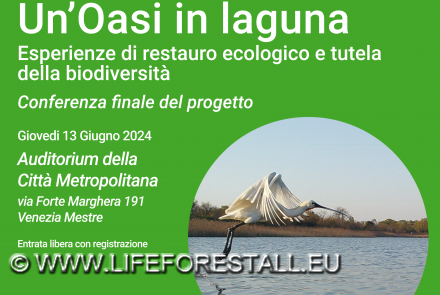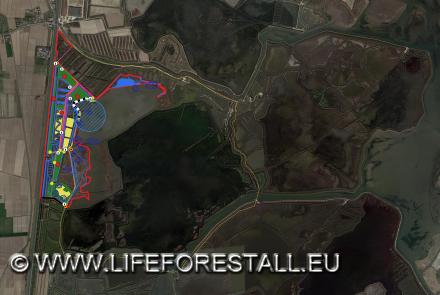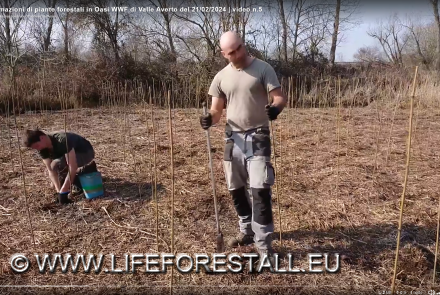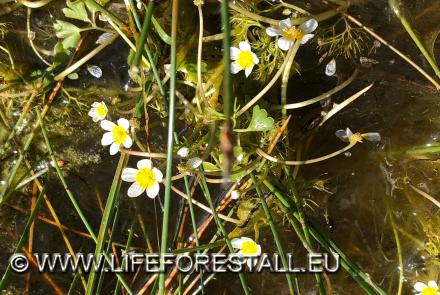The LIFE FORESTALL project
-
Description
-
LIFE18 NAT/IT/001020 LIFE FORESTALL has received funding from the European Union's Programme for the Environment and Climate Change (LIFE).
Title
Restoration of Alluvial Forests and Cladium mariscus habitats in Ramsar and Natura 2000 sites
Acronym
LIFE FORESTALL
Duration
Start date – 01/10/2019
End date – 30/06/2024
Budget
Total project budget: 1,805,433 Euro
Total eligible project budget: 1,800,547 Euro
EU financial contribution requested: 1,344,941 Euro (≅75% of total eligible budget)
-
Objectives
-
LIFE FORESTALL has, as its main objective, the restoration and conservation of habitats 7210* Calcareous fens with Cladium mariscus and species of the Caricion davallianae and 91E0* Alluvial forests of Alnus glutinosa and Fraxinus excelsior, both priority according to the "Habitat" Directive (1992/43/EEC).
The dredging of selected sectors of the existing channel network and the installation of new locks has been foreseen in order to improve the water quality and allow the regulation of the water levels, to guarantee the optimal conditions for resting and feeding of the birds during the winter and the migration period and to encourage the natural expansion of the project habitats.
LIFE FORESTALL project also aims to contain some invasive exotic species such as tree and shrub plants Robinia pseudoacacia and Baccharis halimifolia and Silurus glanis (catfish).
-
Project area
-
The project area is the WWF Oasis of Valle Averto, 78 ha. owned by the WWF Italy, in the southern part of the Venice Lagoon, an environment of extraordinary naturalistic interest. The WWF Oasis of Valle Averto is part of two Natura 2000 sites and it is included in the list of “Wetlands of International Importance” according to the Ramsar Convention.
Flora and fauna in Valle Averto well represent some peculiar features of the wetlands of the North Adriatic Sea. Anthropic pressures and climate changes put the specific biodiversity of this environment at risk and active protection actions are necessary to preserve it.
-
Social inclusion
-
Some activities will be carried out by a social cooperative, demonstrating how environmental restoration can also promote the social and work integration.
-
Partners
-
The project beneficiaries are:CORILA, Consorzio per il coordinamento delle ricerche inerenti al sistema lagunare di Venezia (Coordinatore)
SELC soc. coop.
WWF Oasi soc. Unipers. s.r.l.
Provveditorato Interregionale per le Opere Pubbliche per il Veneto, Trentino Alto Adige, Friuli Venezia Giulia del Ministero delle Infrastrutture e dei Trasporti
Cooperativa Sociale Primavera Società Cooperativa Sociale ONLUS.
Actions
- Preparatory actions
-
A1 PROJECT ACTION PLAN
A2 EXECUTIVE PLANS
- A2.1 Executive plans of habitat and species management works and permits
- A2.2 Executive plan of the hydraulic management works
A3 APPROPRIATE ASSESSMENT (VINCA)
A4 SUBCONTRACTING AND GREEN PROCUREMENT PROCEDURES
A5 REVIEW AND ANALYSIS OF EXISTING ENVIRONMENTAL DATA ON THE INTERVENTION SITES
A6 HYDRO-GEOLOGICAL, WATER AND SOIL CHARACTERIZATION OF INTERVENTION SITES
A7 VEGETATION AND HABITAT MAPS UPDATING
A8 BIRDS MONITORING IN WINTER AND BREEDING SEASON
A9 INVASIVE FISH SPECIES (Silurus glanis) DETECTION
- Conservation Actions
-
C1 HYDRAULIC WORKS TO IMPROVE WATER CIRCULATION AND QUALITY
C2 PROTECTING AND INCREASING 7210* CLADIUM HABITAT
C3 RESTORING AND INCREASING 91E0* ALLUVIAL FOREST HABITAT
C4 RAFT BUILDING FOR BREEDING WADERS AND TERNS
C5 REDUCTION OF PLANT INVASIVE SPECIES OCCURRENCE
C6 INVASIVE FISH SPECIES (Silurus glanis) CONTROL
C7 VISITOR EXPERIENCE ENHANCEMENT
- Monitoring of the impact of the project actions
-
D1 HYDROLOGICAL AND MORPHOLOGICAL MONITORING
D2 VEGETATION MONITORING
D3 EFFECTS OF PROJECT ACTONS ON WINTERING AND BREEDING BIRDS
D4 INVASIVE FISH SPECIES (Silurus glanis) OCCURRENCE
D5 SOCIO ECONOMIC IMPACT
D6 PROJECT IMPACTS ON THE ECOSYSTEM FUNCTIONS
D7 PROJECT PERFORMANCE INDICATORS MONITORING
- Public awareness and dissemination of results
-
E1 DISSEMINATION PLANNING AND EXECUTION
- E1.1 Dissemination and communication plan
- E1.2 Networking with other projects
- E1.3 Development of the dissemination pack
- E1.4 Environmental education and awareness on Natura 2000 network
- E1.5 Effective dissemination to the general public
E2 ACTIVITIES TO ENSURE REPLICABILITY OR TRANSFERABILITY
- E2.1 Dissemination activities targeted to local eco-tourism-stakeholders group
- E2.2 Strategic Transferability Plan for Conservation Management and Habitat Restoration for Wetlands
- Project management
-
- F1 PROJECT MANAGEMENT BY CORILA
- F2 PROJECT MONITORING ACTIVITIES
- F3 PROJECT MEETINGS AND CONFERENCES
- F4 AFTER LIFE PLAN
Watch the Concrete Conservation Actions video below
Download the Dissemination Pack (Final Volume with Best Practices, project brochure...)
Project numbers
Map of interventions







